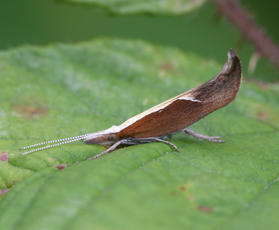Honeysuckle Moth - Ypsolopha dentella
Wingspan 18 to 23 mm. The upturned wingtips are typical of several other moths in this genus, but are more marked in this species.
Around Honeysuckle, the larval foodplant.
This small but distinctive moth flies in July and August and is attracted to light.
As the English name suggests, the larval foodplant is honeysuckle (Lonicera). The young caterpillars are inconspicuous, and as they grow, they change to an attractive purple and green colour which affords surprisingly good camouflage amongst honeysuckle leaves. The pupa is inside a long, spindle-shaped cocoon typical of the genus.
A fairly common species throughout Britain. In the Butterfly Conservation’s Microlepidoptera Report 2011 this species was classified as common.
Fairly common in Leicestershire and Rutland. L&R Moth Group status = A (common and resident).
Leicestershire & Rutland Map
Enter a town or village to see local records
MAP KEY:
Yellow squares = NBN records (all known data)
Coloured circles = NatureSpot records: 2020+ | 2015-2019 | pre-2015
UK Map
Species profile
- Common names
- Honeysuckle Moth
- Species group:
- Moths
- Kingdom:
- Animalia
- Order:
- Lepidoptera
- Family:
- Ypsolophidae
- Records on NatureSpot:
- 68
- First record:
- 18/07/2003 (Skevington, Mark)
- Last record:
- 16/08/2023 (Poole, Adam)
Total records by month
% of records within its species group
10km squares with records
The latest images and records displayed below include those awaiting verification checks so we cannot guarantee that every identification is correct. Once accepted, the record displays a green tick.
In the Latest Records section, click on the header to sort A-Z, and again to sort Z-A. Use the header boxes to filter the list.










